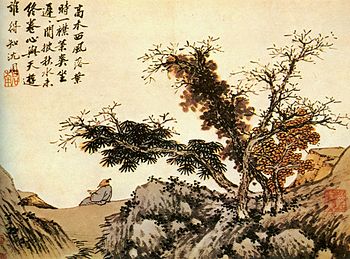- Classical Chinese poetry genres
-
Main articles: Chinese poetry and Classical Chinese poetry
Classical Chinese poetry forms are those genres which typify the traditional Chinese poems written in Classical Chinese. Some of these genres are attested to as early as the publication of the Classic of Poetry, dating from a traditionally, and roughly, estimated time of around BCE 500, in what is now China, but at that time was composed of various independent states. The term "genres" refers to various considerations as to topic, theme, and subject matter, what similes or metaphors were considered appropriate or how they would be interpreted, and other considerations such as vocabulary and style. These genres were generally, but not always independent of the Classical Chinese poetry forms. Many or most of these were developed by the Tang Dynasty and use and development of Classical Chinese poetry genres actively continued up to until the May Fourth Movement, in 1919, and are not totally extinct even today in the 21st century.
Contents
Landscape style poetry genre
Similarly to the classification of Chinese painting, some poetry is regarded as "landscape poetry", because it primarily utilizes images of scenes of nature. Similarly, this genre may be divided into two sub-genres: the more domestic "Fields and Gardens" and the wilder "Rivers and Mountains" (shansui shi).[1]
Rivers and Mountains (山水)
One of the greatest exemplars of this type of poetry was Wang Wei.[2]
Fields and Gardens (田園)
Tao Qian, also known as Tao Yuanming, wrote poems exemplifying this form.[3]
Frontier Fortress (邊塞)
Also known as "Beyond the Borders", this genre of Classical Chinese poetry deals with the experiences, real or imagined, of life on the edge of the Chinese empire, especially in the arid regions to the North and West, which were also subject to temperature extremes and sand and dust storms, populated with sometimes exotic and often hostile people, yet these frontier areas were important, both actually due to imperial ambitions as well as the Silk Road trade, as well as symbolically.
Huiren, "palindrome" poem style
The major exponent of this was Su Hui.
Midnight Songs poetry
Main article: Midnight Songs poetryMidnight Songs poetry also known as, Zi Ye, or "Lady Midnight" style, supposedly originating with an eponymously-named fourth century professional singer of the Eastern Jin dynasty.[4]
See also
- Chinese literature, Classical poetry section
- Chinese poetry
- Classical Chinese poetry
- Ci (poetry)
- Classic of Poetry
- Five Classics
- Fu (poetry)
- Han poetry
- Jueju
- List of Chinese language poets
- Qu (poetry)
- Rime dictionary
- Rime table
- Shan shui
- Tang poetry
- Tone pattern
- Xiaoxiang
Notes
References
- Davis, A. R. (Albert Richard), Editor and Introduction, The Penguin Book of Chinese Verse. (Baltimore: Penguin Books (1970).
- Frankel, Hans H. (1978). The Flowering Plum and the Palace Lady. (New Haven and London: Yale University Press) ISBN 0-300-02242-5
- Hinton, David (2008). Classical Chinese Poetry: An Anthology. New York: Farrar, Strauss, and Giroux. ISBN 0374105367 / ISBN 9780374105365.
- Yip, Wai-lim (1997). Chinese Poetry: An Anthology of Major Modes and Genres . Durham and London: Duke University Press. ISBN 0-8223-1946-2
- Watson, Burton (1971). CHINESE LYRICISM: Shih Poetry from the Second to the Twelfth Century. New York: Columbia University Press. ISBN 0-231-03464-4
External links
- Chinese Wikipedia article on Shi (詩) Chinese Wikipedia article on Shi (詩)
- Chinese Poems, a collection of Chinese poems in the original Chinese, pinyin and English translations
- Understand the basic forms of jintishi (regulated verse)
Categories:- Chinese poetry
- Genres of poetry
Wikimedia Foundation. 2010.

